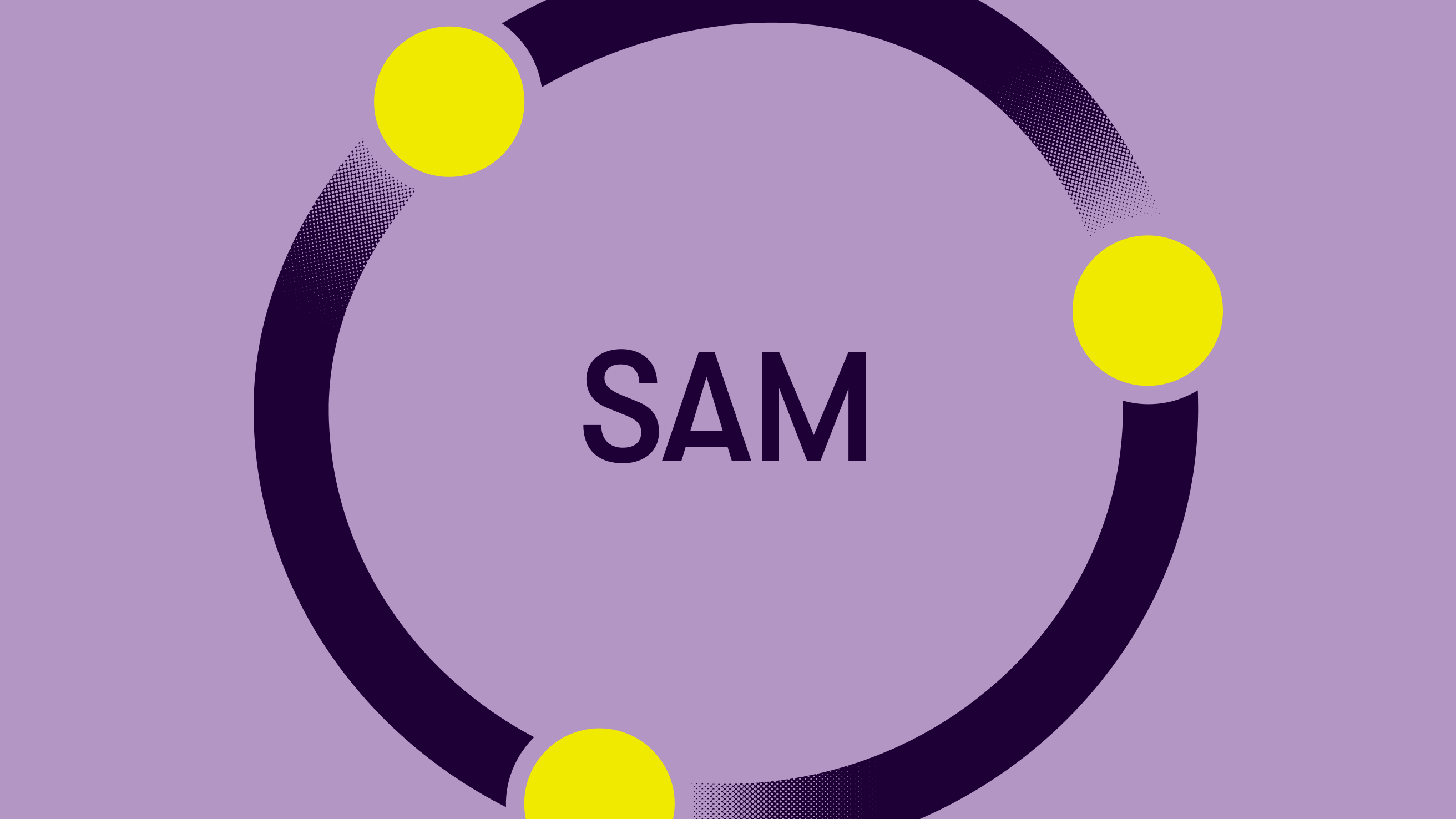SAM model
Read more about The Successive Approximation Model (SAM) for instructional design for delivering engaging training programs.

To compete in today’s business world, organizations must utilize effective training programs that develop the individual skills of their employees and enhance the collective output of their workforce as a whole.
It can be challenging for subject matter experts to convert their knowledge into well-structured courses for a new audience to learn.
However, within instructional design, various models offer different approaches and frameworks to building engaging learning and development programs, irrespective of content or audience. One of the most well-known is SAM.
Discover:
- What is SAM?
- A short history of SAM
- Basic and extended variations of SAM
- 3 phases of SAM
- Advantages and disadvantages of SAM
- What is the difference between ADDIE and SAM?
What is SAM?
The Successive Approximation Model (SAM) for instructional design offers an iterative framework to develop engaging training programs quickly.

The model consists of 3 steps:
- Preparation
- Iterative design
- Iterative development
Using SAM leads to rapid prototyping or drafting, where the first iteration is only an approximation of the final training program. SAM focuses on improving the course with each successive version rather than attempting to deliver a perfect course the first time.
By revisiting each step, taking on board feedback, corresponding with stakeholders and subject matter experts, and working with learning experience designers, SAM quickly revises itself to produce a better experience for learners.
A key concept within SAM is that it is easier to assess a product than an idea. With rapid prototyping, organizations can see the program in action, give meaningful feedback, and perform extensive testing.
During lengthy analysis typical in other instructional design models, teams can only discuss the hypothetical impact of an idea still under development.
SAM requires tight deadlines and fast turnarounds to generate new course material or content and potentially overhaul the entire structure.
Compared to other instructional design models, SAM aims to reduce the time between the initial concept and the final program.
SAM is not industry-specific; its implementation can be beneficial regardless of audience, type of content, or scale.
A variation of the popular ADDIE model, SAM offers a faster and more agile approach to instructional design. Rather than following the rigorous five-step ADDIE process, SAM is recursive in nature, looking to obtain feedback and build working programs earlier in the process.
SAM offers a range of benefits for organizations looking to design a new training program.
- Often the most challenging part of learning and development is finding a starting point. With SAM’s clear framework, teams can quickly prototype new training programs.
- SAM allows organizations to continuously adjust and improve courses based on honest feedback rather than trying to predict what will work beforehand. This process continues over the training program’s entire lifetime. If the makeup of your workforce changes or the course’s purpose needs updating, SAM provides the structures to test new approaches.
- Development through implementing new approaches with SAM can lead to more engaging learning environments and finding the optimal course structure for a specific audience type.
- An effective shortcut within instructional design, SAM means design and development happen simultaneously through repetitive attempts at producing a successful end product. This can dramatically reduce the timescales when developing new training programs.

Training evaluation form
Get a handy printable form for evaluating training and course experiences.
Download nowResearch shows using SAM methods to develop e-learning content produced a more impactful and user-friendly learning environment compared to traditional techniques. These results were based on the learner’s perspective using real-world examples of SAM for instructional design and e-learning content development.
A short history of SAM
Instructional systems design (ISD) dates back to the 1950s with the work of psychologist Robert Gagne. Before ISD, teaching was restricted mainly to behaviorist learning theory that focuses primarily on outputs and not processes along the way that improves the retention of information.
Gagne introduced a more systematic approach to learning that included new structures, sequential processes, and more time placed on instructional material design.
Soon after, in the 1970s, the ADDIE model was developed by a team from The Centre for Education Technology at Florida State University to act as a guide for instructional design
While ADDIE went on to find widespread use, many found its rigid and linear structure and its slow nature a barrier to developing new training programs. While ADDIE has evolved and become more agile in some respects, its fixed sequential approach remains a problem for many potential users.
SAM is a derivative of the ADDIE model first introduced in 2012 by Michael Allen, CEO of Allen Interactions. With a Ph.D. in educational psychology, Michael Allen was an advocate of ADDIE for many years before looking to develop a more rapid and agile instructional design model. His company, Allen Interactions, is active in the field of e-learning, training and consultation services. He is also the author of many books, including “Michael Allen’s Guide to e-learning” and “Leaving ADDIE for SAM.”
Basic and extended versions of SAM
SAM scales based on the size of the project, with two main variations:
First variation is SAM1 – Basic version for smaller projects

Second variation is SAM2 – Extended version for complex projects

While there are many similarities, requiring feedback loops, and continual iteration, SAM2 is better suited to larger-scale projects requiring substantial planning, formal budgeting, multiple stages of approval, and many stakeholders involved.
SAM1 serves as a self-contained approach to the simple, fast, and flexible model, ideal for individuals or small teams looking to build online courses or short instructional programs.
SAM1 contains three simple stages:
- Evaluate – SAM1 disregards the preparation phase. Instead, ideas are evaluated and assessed before moving on to designing the program.
- Design – Incorporate new design approaches into existing course material.
- Develop – Complete and implement the prototype while getting feedback for the next evaluation stage.
Instructional designers cycle through each process until a successful program is reached.
SAM1 allows for very rapid production of training programs where feedback is quickly obtained during the prototyping and testing of different ideas.
In comparison, the more extensive SAM2 contains a dedicated preparation process and a series of repeating steps broken down into two iterative phases.

Training evaluation form
Get a handy printable form for evaluating training and course experiences.
Download now3 Phases of SAM
Below is a more detailed introduction to SAM2, generally considered the main application of the model.
Preparation phase

The preparation phase involves gathering all the background information on the intended audience and defining desired outcomes for the training program.
This includes identifying the resources already available to you and potentially conducting additional research such as surveys for audience research or meeting subject matter experts to better understand the information you want to convey.
By the end of the preparation phase, you need to understand:
- Who within your organization is the target audience for the training program?
- What skills do they need to acquire?
- What is the best style and environment to deliver the training?
- What constraints do you have to operate in?
In other instructional design models, the information gathering and analysis phase is a lengthy, comprehensive process.
Utilizing SAM, teams should apply a quick preparation phase, rapidly prototyping and assessing new design ideas.
Iterative design phase

The goal of the design phase is to plan and prototype course structures, content, and material for evaluation by key parties.
While the preparation phase may involve input from a significant number of people, during the iterative design phase, the team generally shrinks to the subject matter experts (people with the knowledge) and the instructional designers (people converting this knowledge into the training program).
The first step of the iterative design phase is the Savvy start. This is the initial brainstorming session for team members to collaborate, develop ideas, and establish the project’s foundations moving forward.
During the Savvy start, the team designs, prototypes, and reviews a range of ideas, ensuring input from all stakeholders. While SAM is an iterative process and feedback occurs throughout, having initial support for the project’s direction from the entire team helps map out critical requirements for the future program.
By the end of the Savvy start, you should have a list of all the good ideas discussed and a final choice to proceed with.
Next comes project planning and deciding how to build the idea into a functional training program.
Project planning requires setting timelines and budgets and breaking the project into a series of tasks, assigning each to the relevant parties. Examples include scriptwriters and graphic designers capable of producing material for the training program.
After project planning, the last stage (for this iteration) is performing additional design. This means taking initial design decisions and polishing the material produced.
A good tactic during additional design is to create multiple final versions for testing in the next phase. This can also make the team more creative and prevent tunneling on a single approach.
Finally, remember that the key to SAM is iteration; you will return and repeat the design phase to improve the course content and develop new ideas. Review what you made in the previous iteration and identify the necessary changes based on real-life feedback during implementation.
Iterative development phase

The third phase of SAM is iterative development, where the team fully develops the chosen prototype for implementation.
Once implemented (i.e., delivered to an audience), the program’s impact is evaluated through audience feedback, where further design and development may occur.
The iterative design phase involves a loop of developing, implementing, and assessing until the final training program is ready for large-scale rollout.
Before implementing the prototype, it is essential to finalize all aspects by creating a design proof. This proof checks all the work from the design phase, ensuring every element is fully functional and contains all the components needed for a complete product.
The iterative development phase generally contains three full releases of the final program:
- Alpha – The first version of the complete program to evaluate the basic design of the course. While all course components are usable from start to finish, the alpha version may only contain rudimentary content or placeholders for further development.
- Beta – A modified version of the alpha release, the beta version is an update based on feedback. Generally, the beta release sets the final course structure, activities, and methodology. In addition, it is the last opportunity for organizations to test and review any new ideas from the alpha release. If the beta release requires no additional release, it may become the final gold version.
- Gold – The final release ready for full deployment.
If significant problems persist (likely due to unclear initial goals), you may need to repeat the alpha, beta, and gold release process.
During these iterations, the team should continually assess the project to speed up any corrections and reduce the risk of going over budget or missing the final deadline.
Taking an iterative approach to design and development increases flexibility and identifies any weak points in the program earlier in the process when it is easier to change. This requires feedback from the program’s audience and the key stakeholders involved.
Video: 8 Reasons SAM Could Be Your L&D Performance Breakthrough by Allen Interactions
Advantages and disadvantages of SAM
Advantages
- Quick improvements – SAM produces fast and imperfect solutions with the knowledge it will quickly improve with future iterations. This allows for testing multiple approaches and can increase creativity (failure is ok, instructional designers are free to try something new). Generally, once the team receives feedback and the end solution begins to crystallize, the iteration process speeds up.
- Flexibility – Iteration inherently allows for flexibility. With quickfire prototyping and implementation, you aren’t wedded to an original idea that took significant analysis to settle on.
- Reduced costs and timeframes – SAM allows for changes in real-time that, when done right, get you to a successful solution faster than other instructional design models. This saves your organization time and money.
- Early feedback – It is much easier to determine the pros and cons of a particular training program when you see it in action. Rather than spending significant time assessing the merits of different ideas and strategies, SAM gets the course in front of real people to receive early feedback that guides future steps.
Disadvantages
- Repetition – With more steps involved, more mistakes are possible.
- Wasted resources – Mistakes lead to wasted resources with considerable time and money spent developing ideas unsuitable for large-scale rollout.
- Too broad – Testing a wide range of ideas can make it hard to determine the optimal outcome. Significant analysis and research rather than fast prototyping can focus the team on the best approach from the outset.
What is the difference between ADDIE and SAM?
As we previously mentioned, SAM is a derivative of the ADDIE model, with Michael Allen developing it as a direct alternative.
SAM and ADDIE take a fundamentally different approach to instructional design. SAM makes small iterative steps to achieve the final program, whereas ADDIE makes considered large steps based on significant analysis.
Video: ADDIE vs. SAM for eLearning by Tim Slade
There is no right or wrong approach to instructional design, and the choice of model depends on the organization and its learning and development team. For a more detailed comparison of the two models, please see the final section of our piece on the ADDIE model here.

L&D strategy framework
You will receive a list of questions along with a spreadsheet template to help you analyse your L&D strategy.
DOWNLOAD FRAMEWORK



